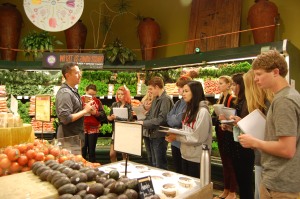At Whole Foods, they understand that “organic” is not the same as “healthy.” Plenty of organic foods are healthy, but salt, sugar, and fat are all easy to overdose on, and can all be considered organic. So what makes food “organic?” Nicolas Martinez, our guide on our trip to our local Whole Foods, explained that “organic” is simply a different way to grow food. Farmers who are USDA certified organic (and even some who aren’t) grow their food very sustainably, without GMO’s and while maintaining a clean, healthy environment for their crops and animals. If something is marked as organic, that is what it means. Now, these organically-grown plants and animals can then be processed to make organic potato chips and organic ice cream, and while they are a better option than the non-organic brands due to their earth-friendliness, they aren’t going to help you lose 15 pounds for your aunt’s next wedding.

Careful! These potato chips will gladly help you gain weight, no matter how sustainably they’re grown. (http://tinyurl.com/pcs4n24)
Only organic foods make it onto the shelves at Whole Foods, and that is one reason why some people avoid the store. Many times, organic foods are marked up more than others because of the aforementioned misconception that if something is organic, then it is therefore better for you, and will cost more money. Whole Foods tries its best to combat this stereotype by keeping their prices reasonably low and offering sale prices. (But since the price tags can’t be seen from the street, it’s up to us to spread the word.)

See that yellow sign? If you look really closely, you can kind of see a sale price on it. Now try seeing it while you’re at Walmart. Photo credit to Karen.
Whole Foods takes a lot of pride in its stock, which is one of the main reasons why they only stock organic food. (Another reason is that the USDA will no longer acknowledge organic food that has touched conventional food as organic.) However, they also stock freshly cut fruit, which is great for a snack, but since they cut the fruit in-store and do not use preservatives, they go bad quickly. Technically, the fruit is good for five days after it is cut and shelved, but it is taken down after two days to maintain the visual aspect of Whole Foods. But since the food can’t simply be tossed, Whole Foods donates all the leftover fruit to Roadrunner Food Bank, who then distributes it to people in need all across the state. If any of the food in the store goes bad, then it is taken to the back of the building to the compost bins, which are occasionally given to Soilutions.
Whole Foods has high-quality, organic food for low prices, so don’t forget it next time you need groceries! We visited the Whole Foods on Academy and Wyoming, at 5815 Wyoming Boulevard NE.
As for the new National Geographic food portal, I quite enjoy it. The home page is a bit too image-heavy for my tastes, but perhaps more visual people will appreciate it. I read an article I found there called “Disease Detective: Tracing Infection Back to Your Seafood.” It was about a small outbreak of Mycobacterium marinum, a skin and soft tissue infection, in New York. McKenna, the writer, recounts Dr. Kari Yacisin’s investigation of the source of the infection. We discover the clues as Yacisin does, and experience her frustration when she comes across a dead end. I really enjoyed this article because it is not simply a report of something that happened, or general information, but rather an educational piece. McKenna’s writing makes it quite the experience, and the frustration and disappointment felt at the end of the article really drives her message: that the food industry is imperfect, so we must work to improve it and be careful in the meantime.
-Gabi
Good title – but you need an image! Your writing is perfect! Detailed and provides the kind of information that the reader WANTS to know. Your style is personal yet professional. Good inclusion of links. You forgot to comment on the Nat Geo readings! Make sure you read the assignment criteria.